The Silver Coffin of King Psusennes I is one of the most stunning and significant archaeological discoveries from Ancient Egypt. Found in 1940 at the Tanis necropolis, this magnificent artifact has captivated historians, archaeologists, and enthusiasts for decades. It is not only a testament to the artistry of ancient Egyptian craftsmanship but also offers valuable insights into the burial practices of the 21st Dynasty. Follow archeology.dulichvn.net to discover many hidden mysteries that have yet to be discovered.
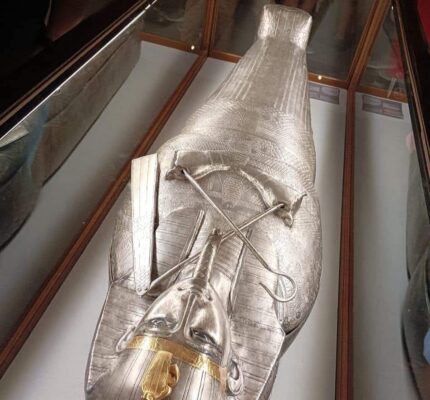
Discovery of the Silver Coffin
Unearthed in Tanis: The Discovery of the Silver Coffin
The Silver Coffin of King Psusennes I was unearthed in 1940 during archaeological excavations at the necropolis of Tanis, a site steeped in history and shrouded in mystery. Tanis, once a bustling city in Egypt’s 21st Dynasty, held the secrets of royal burials that had remained hidden for centuries. Among these treasures, the silver coffin emerged as a discovery of monumental significance, not only for its exquisite craftsmanship but also for the insights it provided into the funerary practices of the time.
The coffin was located in the tomb of Psusennes I, a prominent pharaoh of the 21st Dynasty, whose burial chamber stood out for its relative simplicity compared to the grandiose tombs of earlier periods. Despite this, the coffin’s lavish use of silver—a rare and precious material in ancient Egypt—spoke volumes about the status and legacy of the king. This find has since become a cornerstone for understanding how the Egyptians adapted their burial practices during a period marked by political and economic transitions.
Pierre Montet: The Visionary Archaeologist
The remarkable discovery of the Silver Coffin owes much to the expertise and dedication of French archaeologist Pierre Montet. Leading the excavation efforts at Tanis, Montet demonstrated exceptional skill and patience, meticulously uncovering a series of royal tombs that had long eluded other explorers.
Montet’s work was not without its challenges. The necropolis had been subject to centuries of erosion, looting, and the passage of time, making it a difficult site to navigate. Yet, his methodical approach and unyielding focus led him to uncover a treasure trove of artifacts, with the silver coffin being the crown jewel. This find was more than just an archaeological triumph—it reshaped the study of Egypt’s 21st Dynasty, revealing a wealth of information about a relatively obscure period in the country’s history.
The discovery of the coffin by Montet is considered one of the most significant in the annals of Egyptology, comparable to the unearthing of Tutankhamun’s tomb in its historical and cultural impact. Montet’s work ensured that the story of Psusennes I and the artistry of his time would not be lost to history.
Tanis Necropolis: A Royal Resting Place
The Tanis necropolis, where the Silver Coffin of Psusennes I was found, serves as a poignant reminder of the city’s ancient glory. Once the capital of the Tanite Dynasty, Tanis flourished as a center of political and religious power during the 21st Dynasty, roughly between 1070 and 945 BCE.
This necropolis was the final resting place of several pharaohs and high-ranking officials, making it a site of immense historical importance. Unlike the grand Valley of the Kings, the royal tombs at Tanis reflected a more subdued, yet equally fascinating, approach to burial practices. The use of precious metals like silver and gold in the construction of coffins and burial artifacts underscored the wealth and sophistication of Tanite society, even during a time of national fragmentation.
The necropolis at Tanis also highlights the adaptation of religious and cultural traditions during the late New Kingdom and Third Intermediate Period. The discovery of Psusennes I’s silver coffin and other burial artifacts provides a unique window into the shifting dynamics of this era, from the evolving role of the pharaoh to the interplay of regional powers within Egypt.
In the context of Egypt’s broader history, the Silver Coffin of King Psusennes I stands as a testament to the resilience of a civilization that, even in times of change, continued to produce works of extraordinary beauty and significance.
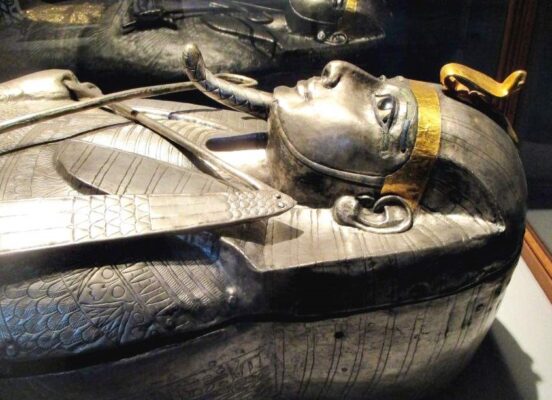
The Design and Craftsmanship of the Silver Coffin
Made of Silver and Wood: An Artistic Masterpiece
The Silver Coffin of King Psusennes I is a breathtaking example of ancient Egyptian craftsmanship, combining the brilliance of silver with the intricate detail of woodwork. This unique coffin is primarily composed of silver, with carefully applied silver plating that envelops the entire structure. The silver gives the coffin a shimmering, ethereal quality, reflecting the light in a way that would have made it appear almost otherworldly. The coffin is meticulously shaped to resemble the king’s body, with fine contours that create a striking and lifelike representation of the deceased monarch.
The use of silver on such a grand scale was rare, and its application here underscores the importance of the pharaoh and his elevated status in life and death. The coffin’s design is not only functional but deeply symbolic, with every curve and detail crafted with remarkable precision. The delicate engravings and carvings adorning the surface of the coffin illustrate the advanced artistry that was achieved during this period of ancient Egypt, showcasing the high level of skill possessed by Egyptian artisans of the time.
Depictions of the King: A Royal Legacy
The engravings on the Silver Coffin of Psusennes I are a testament to the king’s divine status and royal authority. The detailed representations on the surface of the coffin serve as visual narratives of his reign, providing a glimpse into the king’s power, identity, and relationship with the gods. The most striking feature is the depiction of the king’s face, captured in elegant detail. His regal expression, paired with symbols of royal power, such as the double crown of Upper and Lower Egypt and the scepter of authority, reinforces his status as a ruler chosen by the gods to lead his people.
These engravings go beyond mere portraits; they are symbolic of Psusennes I’s divine nature, portraying him not only as a mortal king but also as a god-like figure. The inclusion of specific symbols associated with his reign further connects the king to the ancient Egyptian belief in the afterlife, emphasizing that his journey did not end with death. Instead, the artwork on the coffin signifies his continuing role in the afterlife, reinforcing his eternal reign.
Symbolism of the Silver Material: A Sacred Journey
In ancient Egypt, silver was more than just a precious metal; it was considered sacred and imbued with symbolic meaning. The Egyptians often associated silver with the moon, which represented immortality and the cyclical nature of life and death. This connection to the moon made silver an ideal material for the burial of a king, symbolizing his transition from life to the afterlife and his eternal existence beyond the physical world.
The use of silver in the coffin of King Psusennes I signifies not just his wealth and importance, but also his eternal journey. By choosing silver, the king’s tomb is not only a final resting place but a portal to eternity. This material connection to immortality was central to the beliefs of ancient Egyptians, whose religious practices were deeply intertwined with the concept of an everlasting existence in the afterlife.
The symbolic use of silver in the coffin reflects the pharaoh’s desire to leave behind a lasting legacy—one that transcends the limitations of the earthly realm and continues in the divine and immortal sphere. In this way, the coffin becomes not just an artifact of historical significance but a powerful symbol of the king’s enduring legacy, ensuring that Psusennes I would be remembered for millennia to come.
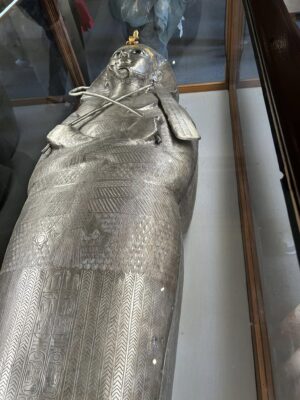
The Historical Significance of the Silver Coffin
Understanding Egyptian Burial Practices: Insights from the Silver Coffin
The discovery of the Silver Coffin of King Psusennes I offers a fascinating window into the burial practices of Egypt’s 21st Dynasty. Unlike the grandiose tombs of the Old and New Kingdoms, characterized by sprawling complexes and towering pyramids, Psusennes I’s burial was more understated. The modesty of his tomb, nestled within the Tanis necropolis, contrasts sharply with the opulence of the silver coffin, which served as the centerpiece of his burial.
This juxtaposition reflects a broader shift in Egyptian society during the 21st Dynasty—a time of diminished centralized power and economic constraints. With resources diverted to maintaining political stability, monumental burial traditions gave way to more economical yet symbolically rich practices. The presence of the silver coffin, an artifact of extraordinary craftsmanship, indicates that while the scale of tombs decreased, the emphasis on ensuring the pharaoh’s passage to the afterlife remained undiminished. This evolution in burial customs underscores the adaptability of ancient Egyptian traditions in response to changing historical and cultural circumstances.
The Mystery of Psusennes I’s Reign: A Ruler Amidst Turmoil
The reign of King Psusennes I, though shrouded in mystery, occurred during a critical juncture in ancient Egyptian history. His rule marked the conclusion of the New Kingdom, a period of great prosperity, and the beginning of the Third Intermediate Period, characterized by political fragmentation and decentralization. As a ruler of the 21st Dynasty, Psusennes I governed from Tanis, a city that had risen to prominence as the political and religious capital of Lower Egypt.
Despite the turbulent era, Psusennes I maintained stability in his realm and cultivated an image of enduring authority. His silver coffin, a rare and opulent artifact, is a reflection of his efforts to secure his legacy amidst the challenges of his time. The coffin and its inscriptions provide tantalizing clues about his reign, hinting at a ruler who navigated a complex political landscape while upholding the divine responsibilities of kingship. The craftsmanship and symbolism of his burial artifacts stand as a testament to his enduring influence, even as Egypt faced significant internal and external pressures.
The Legacy of Psusennes I: An Eternal Connection
The Silver Coffin of King Psusennes I is far more than a relic of ancient Egypt—it is a profound link to a ruler’s enduring legacy. This exquisite artifact, alongside the treasures uncovered in his tomb, immortalizes the king’s name and achievements, offering a tangible connection between the ancient world and contemporary Egyptology.
For modern scholars, the coffin is a source of invaluable insights into the artistry, religious beliefs, and societal priorities of Psusennes I’s time. Its discovery has enriched our understanding of how the pharaohs of the 21st Dynasty adapted to the changing dynamics of their era while preserving the core tenets of Egyptian culture. The symbolism of the silver, the precision of the engravings, and the context of its burial all contribute to a narrative that bridges millennia, highlighting the ingenuity and resilience of ancient Egyptian civilization.
Through the Silver Coffin, Psusennes I’s story continues to captivate and inspire, ensuring that his legacy endures not only as a historical figure but as a symbol of a civilization that thrived even in the face of adversity. His burial reflects the timeless human pursuit of remembrance and immortality, offering a poignant reminder of the enduring power of legacy.
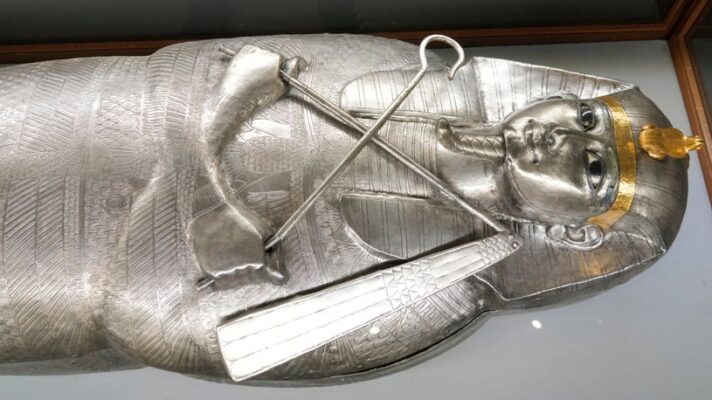
See more: Ra and Hathor: Divine Forces in Egyptian Mythology
Conclusion: A Glimpse into Ancient Egypt’s Royal Past
The Silver Coffin of King Psusennes I is more than just a stunning artifact. It is a window into the complex world of ancient Egyptian royalty, showcasing the advanced craftsmanship, symbolism, and rituals associated with the afterlife. Its discovery in the Tanis necropolis continues to inspire awe and curiosity about the ancient Egyptians and their enduring cultural legacy. Through this extraordinary find, we are reminded of the ingenuity and timelessness of ancient Egyptian civilization.

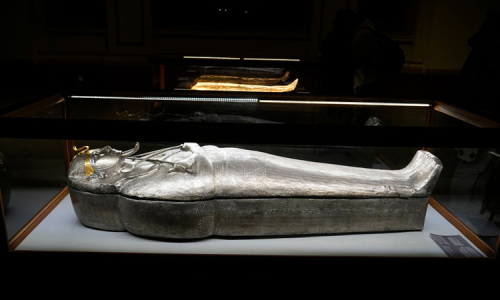
CÁC TIN KHÁC
Mary Walton: The Forgotten Inventor Who Helped Clean Up America’s Cities
Tomb of Queen Nefertari in the Valley of the Queens, Egypt
Discover the Hypostyle Hall of the Temple of Hathor at Dendera
Venus de Losange: Unveiling the Mystery of a 20,000-Year-Old Paleolithic Icon